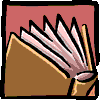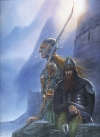|

-=[RBoW]=-
home
Click
the arrow down
to reveal the menu
| Tolkien
info ... |
 |
|
| Download
... |
 |
|
| Links...
|
 |
|

Comments/requests?
Sign Guestbook
View
Guestbook
|
|

"The world
is divided in those who have read The Hobbit and the Lord
of the Rings and those who are going to read them." - The
Sunday Times
The
most important works of J.R.R. Tolkien (chronological)
 Sir
Gawain and the Green Knight;
Sir
Gawain and the Green Knight;
with E.V. Gordon (1925, Oxford University Press)
Translation of
and comments on this ancient Anglo-saxon myth.
 The Hobbit
The Hobbit
(21 Sep 1937, George Allen & Unwin)
"In a hole
in the ground there lived a hobbit".With these words, the
world of Middle Earth was introduced to the public. In his first
novel, written as a story for his children, Tolkien describes
the journey of Bilbo Baggins to the Lonely Mountain. Thirteen
Dwarves, a Wizard and a Hobbit on the hunt for a treasure, guarded
by Smaug the Dragon. The novel was accepted by Allen & Unwin
after the son of the publisher, 10-year old Rayner Unwin, had
given his approval to the story.
 Leaf
by Niggle
Leaf
by Niggle
(1945)
A deep work, concerning
despair of mortality. Combined with and essay on faerie tales
also know as "Tree and Leaf" (1964).
 On
Fairy Stories
On
Fairy Stories
(1947, Oxford University Press)
An essay on faerie
tales. Combined with Leaf by Niggle in "Tree and Leaf"
(1964).
 Farmer
Giles of Ham
Farmer
Giles of Ham
(1949, George Allen & Unwin)
A short story
on Farmer Giles, situated in Britain. Giles is a fat farmer
who is the person in the village of Ham to face a dragon.
 The
Homecoming of Beorthnoth
The
Homecoming of Beorthnoth
(1953)
Translation of
an old Anglo-Saxon work. Story of Beorthnoth, the Duke of Essex,
who defended Britain during a raid of the Danes in 992 AD.
 The
Lord of the Rings: Fellowship of the Ring
The
Lord of the Rings: Fellowship of the Ring
(29 Jul 1954, George Allen & Unwin)
In a period of
13 years (1936-1949) J.R.R. Tolkien created his master piece.
Actually, Tolkien started writing LOTR before the Hobbit was
published. After publication of the latter, letters of numerous
fans were sent to the publisher for "more stories on Hobbits".
Although the Hobbit was primarily written as a children's story,
LOTR took the story to a higher level, being far more complicated
and dug far more deeper in the world and history of Middle Earth.
The American edition was published on 21th of October 1954 by
Houghton Mifflin Company.
In the Fellowship
of the Ring, Bilbo's magic Ring is passed to his nephew Frodo,
who, together with his servant Sam and fellow Hobbits Pippin
and Merry embarks on a journey East. In Rivendell, a Fellowship
of Nine is gathered to destroy the One Ring in the Fires of
Mount Doom, from which it was created.
 The Lord of the Rings: The Two Towers
The Lord of the Rings: The Two Towers
(11 Nov 1954, George Allen & Unwin)
In The Two Towers,
the proceedings of the broken Fellowship are described. On the
one hand, the journey of Frodo and Sam to their doom in Mordor
is captured on paper and on the other hand, the Tree Hunters
follow the track of the Uruk-Hai to liberate Merry and Pippin.
In the events following, the power of the wizard Saruman is
resisted by the Men of Rohan.
 The Lord of the Rings: Return of the King
The Lord of the Rings: Return of the King
(20 Oct 1955, George Allen & Unwin)
"He drew
a deep breath. "Well, I'm back", he said". With
these words, the story ends. In the final part of the Trilogy,
the war on the Ring reaches its climax with large epic battles
and individual failure and success.
The Lord of the
Rings Trilogy was critically appraised in the 50's, but did
not reach its current popularity until the 1960's. Since then,
the book has been reprinted many times and has been translated
in more than 20 languages. It was voted "Book of the Century"
in the online survey by Amazon.com. It has inspired a generation
of writers to proceed with a new category in literature, called
fantasy.
 The Adventures of Tom Bombadil and other verses from the Red Book
The Adventures of Tom Bombadil and other verses from the Red Book
(1962, George Allen & Unwin)
Additional poems
and songs, not included in the Lord of the Rings. Includes some
poems concerning Tom Bombadil, the complete Troll poem (by Sam),
The Man in the Moon (sung by Frodo in the Prancing Pony) and
more. Some of these songs are included in the Road goes ever
on songcycle by Donald Swann.
 Smith of Wootton Major
Smith of Wootton Major
(1967, George Allen & Unwin)
Short story on
the Smith of Wootton Major. Tells the story of a giant pie with
magical properties.
 The Road Goes Ever On;
The Road Goes Ever On;
with Donald Swann (1967, Houghton Mifflin Company)
In the 1960's,
Donald Swann was inspired by the songs and poems in the Lord
of the Rings and created the music, to which these songs and
poems could be aligned. He played this songcycle "The Road
Goes Ever On" on Tolkiens Wedding Anniversary in 1966.
Tolkien liked the music, except for "Namarye", for
which Tolkien created his own tune. The songcycle includes "The
road goes ever on" (The song by Bilbo leaving the Shire),
"In the Willowmeads of Tasarinan" (sung by Treebeard
in memory of the lost realm of Beleriand), "Namarye"
(Farewell in Elvish by Galadriel) and 6 other songs.
 The Father Christmas Letters;
The Father Christmas Letters;
edited by Baillie Tolkien (1976, George Allen & Unwin)
Letters Tolkien
wrote to his children at Christmas, in which Father Christmas
writes about the wonderful life on the North Pole.
 The
Silmarillion;
The
Silmarillion;
edited by Christopher Tolkien (1977, George Allen & Unwin)
In the "Quenta
Silmarillion", the story of the Silmarils, the History
of Middle Earth is written. The references in the Lord of the
Rings and the Hobbit to the older matter, such as "Gondolin",
the "Last Alliance", "Beren and Luthien"
are clearified. The Silmarillion consists of a collection of
legends, some of which are worked out well and others are not.
Although parts are written in a somewhat archaic style, it contains
some valuable jewels which are indispensible for Tolkien fans.
The Silmarillion is composed by Tolkiens third son, Christopher
Tolkien, who worked through a pile of notes and papers to reconstruct
his fathers life work, with sketches and notes on Middle Earth
written as early as 1916.
The Silmarillion
tells the story of the creation of Arda, the Earth, and the
higher powers which created it. The story of good against evil
in Middle Earth is set against the War against Morgoth, of whom
Sauron was only a servant. The coming of the Elves, the creation
of their mighty jewels, the Silmarils, which were stolen by
Morgoth sets the campaign for a true tragedy of immense proportions
with themes such as betrayal, doom, personal failure and victory,
hope and despair. It tells of the coming of Men and and some
of their epic deeds, in which the fate of Men and Elves is joined
and from which the lines of the Numenoreans (Aragorn) and the
Elves of Rivendell descend.
 Pictures by J.R.R. Tolkien;
Pictures by J.R.R. Tolkien;
foreword and Notes by Christopher Tolkien (1979, Allen & Unwin)
A collection of
Tolkien's own illustrations for Lord of the Rings, the Hobbit
and the Silmarillion.
 Unfinished Tales;
Unfinished Tales;
edited by Christopher Tolkien (1980, George Allen & Unwin)
Christopher Tolkien
collected his fathers notes and unfinished stories and tried
to fill some gaps the Silmarillion left untold. A collection
of Unfinished Tales, of which "Narn i Hin Hurin",
the story of the children of Hurin, is the most important. Next
to the Silmarillion, an invaluable source on the history and
legends of Middle Earth.
 The Letters of J.R.R. Tolkien;
The Letters of J.R.R. Tolkien;
Edited by Humphrey Carpenter, with the assistance of Christopher
Tolkien (1981, George Allen & Unwin)
A collection
of letters, written by J.R.R. Tolkien, concerning his works.
Provides a clearification on some subjects for the true die-hard
Tolkien adept.
 Mr Bliss
Mr Bliss
(1982, George Allen & Unwin)
 Roverandom;
Roverandom;
edited by Christina Scull and Wayne G. Hammond (1998,
HarperCollinsPublishers)
A story Tolkien
wrote for his 4-year old son Michael, who lost his dog in 1925.
About a dog, Rover, who is magically transformed into a toy.
|
The
History of Middle Earth by CHRISTOPHER TOLKIEN
|
In the History of
Middle Earth (HoME)- series, Christopher Tolkien collected and
edited J.R.R. Tolkiens manuscripts, letters and notes to clarify
a certain subject in the world of Middle Earth.
I
The Book of Lost Tales part 1 (1984)
II
The Book of Lost Tales part 2 (1984)
III
The Lays of Beleriand (1985)
IV
The Shaping of Middle-Earth (1986)
V
The Lost Road and other Writings (1987)
VI The
Return of the Shadow (1988)
VII
The Treason of Isengard (1989)
VIII
The War of the Ring (1990)
IX
Sauron Defeated (1992)
X
Morgoth's Ring (1993)
XI
The War of the Jewels (1994)
XII
The Peoples of Middle-Earth (1996)
<<
back to -=[RedBookofWestmarch]=-
home
A full list
of all Tolkiens publications can be downloaded from PalmTolkien,
in the Tolkien TXT-files download area. A direct link is also
available through the download pulldown menu in the Quick Navigation
Area on the top left on this page.
RELATED
LINKS:
-=[RBoW]=-
The Hobbit : facts, backgrounds and summary of the story
-=[RBoW]=-
LOTR : facts, background and summaries of the trilogy
-=[RBoW]=-
The Silmarillion: facts, backgrounds and summary of this book.
Comments
or requests? Email redbookofwestmarch@yahoo.com
This
page © 2001-2004 by RedBookofWestmarch.
Disclaimer:
Hypertext links and files are provided for backup purposes only.
RedBookofWestmarch is not responsible for the events following
the utilisation of these hypertext links or files. All files have
been investigated with a virus scanner, but before opening files,
additional scanning is strongly advised. If the artist, author,
owner or rights-holder of any content posted herein objects to
the inclusion of such content on this site, please contact us
at redbookofwestmarch@yahoo.com and such content will be removed.
|
This
page was last updated on Tuesday, 14-May-2002 23:09
|
|
|









|

